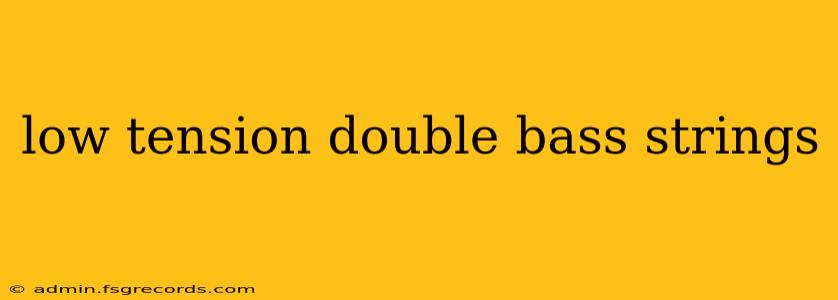Choosing the right double bass strings is crucial for achieving your desired sound and playing experience. For many bassists, particularly those new to the instrument or focusing on specific musical genres, low tension strings offer a compelling alternative to their higher-tension counterparts. This comprehensive guide delves into the nuances of low tension double bass strings, exploring their advantages, disadvantages, and suitability for various playing styles.
Understanding String Tension: The Impact on Tone and Playability
String tension significantly impacts a double bass's overall sound and feel. High tension strings offer a brighter, more powerful tone with increased projection. However, this comes at the cost of increased finger fatigue and potentially more demanding bowing techniques. Conversely, low tension strings provide a warmer, mellower tone that is often described as more "flexible" or "responsive." This reduced tension translates to easier playability, making them ideal for beginners, players with hand injuries, or those focusing on styles requiring a softer touch.
Key Advantages of Low Tension Double Bass Strings
- Enhanced Playability: The lower tension makes it significantly easier to press down the strings, leading to reduced finger fatigue and faster learning curve for beginners. This is particularly beneficial for long practice sessions or performances.
- Warmer Tone: Low tension strings generally produce a warmer, rounder, and less bright tone. This is especially appealing in genres like jazz, folk, and classical music where a mellower sound is preferred.
- Improved Bow Response: The increased flexibility often results in a smoother bow response, facilitating nuanced phrasing and articulation.
- Reduced String Wear: Due to the lower tension, these strings tend to last longer compared to their high-tension counterparts. This translates to cost savings in the long run.
- Better for Older Instruments: Low tension strings are often preferred for older instruments with potentially weaker tops, minimizing the risk of damage.
Potential Drawbacks of Low Tension Double Bass Strings
- Lower Volume and Projection: This is perhaps the most significant trade-off. Low tension strings generally project less volume compared to high-tension strings. This might not be ideal for large venues or orchestral settings where significant volume is required.
- Less Defined Tone: The softer tone, while desirable in certain contexts, may lack the clarity and definition of high-tension strings, making them less suited to genres demanding precise articulation.
- Tuning Stability: While advancements in string technology have minimized this issue, some bassists report slightly decreased tuning stability with low tension strings. Regular tuning is therefore essential.
Choosing the Right Low Tension Double Bass Strings: Factors to Consider
Selecting the perfect set of low tension strings involves careful consideration of several factors:
1. Material:
- Synthetic Core Strings: These offer excellent tuning stability, affordability and are often chosen for their consistent response.
- Gut Strings: Historically popular for their warm tone and expressive qualities, however require more care and are significantly more expensive.
2. Gauge:
- Light Gauge: Offers the lowest tension but compromises volume and projection.
- Medium Gauge: Represents a balanced approach—providing a decent compromise between playability, tone, and volume.
- Heavy Gauge: Approaches the tension of medium tension strings, offering increased projection with minimal impact on playability.
3. Playing Style and Genre:
The musical genre significantly impacts the choice. Low tension strings often excel in jazz, folk, chamber music, and certain classical styles where a warm, mellow tone is prioritized. However, they might prove insufficient for genres requiring louder projection such as rock, metal, or amplified orchestral work.
4. Budget:
While some affordable options are available, certain high-quality low tension strings can be more costly than their high-tension counterparts.
Conclusion: Finding the Perfect Fit
Ultimately, the "best" low tension double bass strings depend on individual preferences, playing style, and musical context. Experimentation and testing different brands and gauges are crucial to find the perfect match. Don't hesitate to consult experienced double bassists or luthiers for personalized recommendations based on your specific needs and instrument. This detailed exploration will hopefully empower you to make an informed decision and enhance your double bass playing experience.

